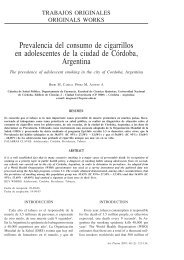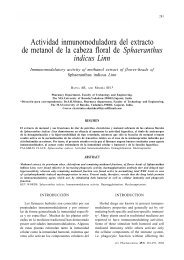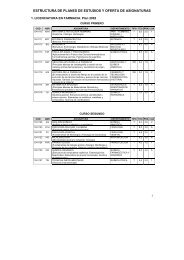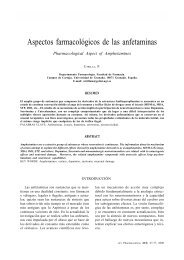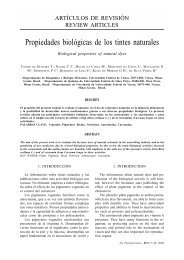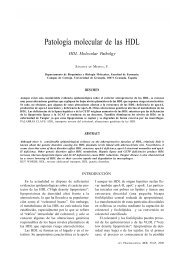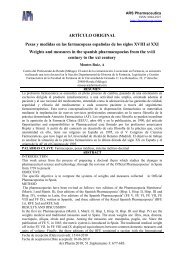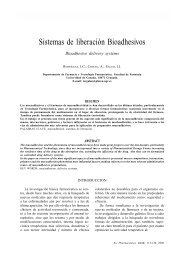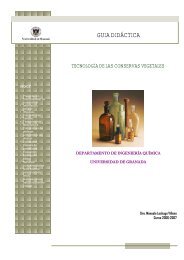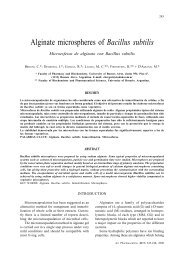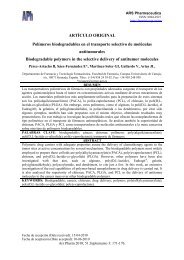Identificación in silico, caracterización molecular y análisis de ...
Identificación in silico, caracterización molecular y análisis de ...
Identificación in silico, caracterización molecular y análisis de ...
You also want an ePaper? Increase the reach of your titles
YUMPU automatically turns print PDFs into web optimized ePapers that Google loves.
IDENTIFICACIÓN IN SILICO, CARACTERIZACIÓN MOLECULAR Y ANÁLISIS DE EXPRESIÓN DE LA PROTEÍNA...<br />
SILICO IDENTIFICATION, MOLECULAR CHARACTERIZATION AND EXPRESSION ANALYSIS OF THE TRYPANOSOMA...<br />
<strong>I<strong>de</strong>ntificación</strong> <strong>in</strong> <strong>silico</strong>, <strong>caracterización</strong> <strong>molecular</strong><br />
y <strong>análisis</strong> <strong>de</strong> expresión <strong>de</strong> la proteína<br />
<strong>de</strong> filamento para flagelar PFR3<br />
<strong>de</strong>l Tripanosoma brucei<br />
Silico i<strong>de</strong>ntification, <strong>molecular</strong> characterization and expression analysis of<br />
the Trypanosoma brucei paraflagellar rod prote<strong>in</strong> PFR3<br />
MORELL M, GARCÍA-PÉREZ JL, THOMAS MC, LÓPEZ MC *<br />
Departamento Departamento <strong>de</strong> <strong>de</strong> Biología Biología Molecular, Molecular, Instituto Instituto <strong>de</strong> <strong>de</strong> <strong>de</strong> Parasitología Parasitología Parasitología y y Biomedic<strong>in</strong>a Biomedic<strong>in</strong>a «López «López Neyra», Neyra», CSIC.<br />
CSIC.<br />
Granada Granada – – SPAIN. SPAIN. * * Correspond<strong>in</strong>g Correspond<strong>in</strong>g author author e-mail: e-mail: mclopez@ipb.csic.es<br />
mclopez@ipb.csic.es<br />
RESUMEN<br />
RESUMEN<br />
En En En el el presente presente artículo artículo se se <strong>de</strong>scriben <strong>de</strong>scriben <strong>de</strong>scriben la la i<strong>de</strong>ntificación i<strong>de</strong>ntificación y y el el aislamiento aislamiento aislamiento <strong>de</strong>l <strong>de</strong>l gen gen codificante codificante para para la la proteína proteína<br />
proteína<br />
PFR3 PFR3 <strong>de</strong>l <strong>de</strong>l <strong>de</strong>l T. T. T. T. T. brucei. brucei brucei brucei brucei . La La secuencia secuencia <strong>de</strong>ducida <strong>de</strong>ducida <strong>de</strong> <strong>de</strong> am<strong>in</strong>oácidos am<strong>in</strong>oácidos am<strong>in</strong>oácidos produce produce una una proteína proteína <strong>de</strong> <strong>de</strong> 592 592 residuos residuos residuos con<br />
con<br />
un un punto punto isoeléctrico isoeléctrico <strong>de</strong> <strong>de</strong> 5,14 5,14 y y y presenta presenta una una i<strong>de</strong>ntidad i<strong>de</strong>ntidad <strong>de</strong> <strong>de</strong> secuencia secuencia <strong>de</strong>l <strong>de</strong>l 68,9% 68,9% con con la la proteína proteína PFR3 PFR3 <strong>de</strong>l<br />
<strong>de</strong>l<br />
T. T. T. T. T. cruzi. cruzi cruzi cruzi cruzi . S<strong>in</strong> S<strong>in</strong> embargo, embargo, embargo, el el porcentaje porcentaje <strong>de</strong> <strong>de</strong> homología homología homología entre entre la la proteína proteína PFR3 PFR3 PFR3 <strong>de</strong> <strong>de</strong> T. T. T. T. T. brucei brucei brucei brucei brucei y y otras otras otras secuencias<br />
secuencias<br />
disponibles disponibles <strong>de</strong> <strong>de</strong> <strong>de</strong> PFRs PFRs <strong>de</strong> <strong>de</strong> T. T. T. T. T. brucei brucei brucei brucei brucei y y T. T. T. T. T. cruzi cruzi cruzi cruzi cruzi es es <strong>in</strong>ferior <strong>in</strong>ferior al al 22%. 22%. En En contraste contraste contraste con con lo lo <strong>de</strong>scrito <strong>de</strong>scrito <strong>de</strong>scrito para para los<br />
los<br />
miembros miembros <strong>de</strong> <strong>de</strong> la la familia familia <strong>de</strong> <strong>de</strong> proteínas proteínas <strong>de</strong> <strong>de</strong> <strong>de</strong> filamento filamento paraflagelar, paraflagelar, la la mayor mayor mayor divergencia divergencia entre entre las las proteínas<br />
proteínas<br />
PFR3 PFR3 PFR3 <strong>de</strong> <strong>de</strong> T. T. T. T. T. cruzi cruzi cruzi cruzi cruzi y y T. T. T. T. T. brucei brucei brucei brucei brucei se se encuentra encuentra en en la la región región central central <strong>de</strong> <strong>de</strong> la la proteína, proteína, con con una una similitud similitud <strong>de</strong>l <strong>de</strong>l 38%<br />
38%<br />
en en 200 200 am<strong>in</strong>oácidos. am<strong>in</strong>oácidos. am<strong>in</strong>oácidos. Estimamos Estimamos que que que existen existen dos dos copias copias <strong>de</strong> <strong>de</strong> la la la proteína proteína PFR3 PFR3 PFR3 <strong>de</strong> <strong>de</strong> T. T. T. T. T. brucei brucei brucei brucei brucei por por genoma<br />
genoma<br />
haploi<strong>de</strong>. haploi<strong>de</strong>. El El gen gen se se transcribe transcribe como como mARN mARN <strong>de</strong> <strong>de</strong> aproximadamente aproximadamente 3,6 3,6 kb kb <strong>de</strong> <strong>de</strong> longitud, longitud, presente presente presente con con la<br />
la<br />
misma misma abundancia abundancia en en formas formas parasitarias parasitarias procíclicas procíclicas y y <strong>de</strong>l <strong>de</strong>l torrente torrente sanguíneo. sanguíneo.<br />
sanguíneo.<br />
PALABRAS CLAVE: Número <strong>de</strong> copias. Gen. Leishmania. Caracterización <strong>molecular</strong>. Proteína <strong>de</strong>l filamento paraflagelar.<br />
<strong>I<strong>de</strong>ntificación</strong> <strong>in</strong> <strong>silico</strong>. Tripanosoma brucei. Tripanosoma cruzi. Transcripción.<br />
ABSTRACT<br />
ABSTRACT<br />
In In In In In the the the the the present present present present present paper paper paper paper paper we we we we we <strong>de</strong>scribe <strong>de</strong>scribe <strong>de</strong>scribe <strong>de</strong>scribe <strong>de</strong>scribe the the the the the i<strong>de</strong>ntification i<strong>de</strong>ntification i<strong>de</strong>ntification i<strong>de</strong>ntification i<strong>de</strong>ntification and and and and and isolation isolation isolation isolation isolation of of of of of the the the the the gene gene gene gene gene cod<strong>in</strong>g cod<strong>in</strong>g cod<strong>in</strong>g cod<strong>in</strong>g cod<strong>in</strong>g for for for for for T. T. brucei brucei PFR3 PFR3 PFR3 PFR3 PFR3<br />
prote<strong>in</strong>. prote<strong>in</strong>. prote<strong>in</strong>. prote<strong>in</strong>. prote<strong>in</strong>. The The The The The <strong>de</strong>duced <strong>de</strong>duced <strong>de</strong>duced <strong>de</strong>duced <strong>de</strong>duced am<strong>in</strong>o am<strong>in</strong>o am<strong>in</strong>o am<strong>in</strong>o am<strong>in</strong>o acid acid acid acid acid sequence sequence sequence sequence sequence produces produces produces produces produces a a a a a prote<strong>in</strong> prote<strong>in</strong> prote<strong>in</strong> prote<strong>in</strong> prote<strong>in</strong> of of of of of 592 592 592 592 592 residues residues residues residues residues with with with with with an an an an an isoelectric isoelectric isoelectric isoelectric isoelectric po<strong>in</strong>t po<strong>in</strong>t po<strong>in</strong>t po<strong>in</strong>t po<strong>in</strong>t<br />
of of of of of 5.14 5.14 5.14 5.14 5.14 and and and and and shows shows shows shows shows a a a a a 68.9% 68.9% 68.9% 68.9% 68.9% sequence sequence sequence sequence sequence i<strong>de</strong>ntity i<strong>de</strong>ntity i<strong>de</strong>ntity i<strong>de</strong>ntity i<strong>de</strong>ntity with with with with with T. T. cruzi cruzi cruzi PFR3 PFR3 PFR3 PFR3 PFR3 prote<strong>in</strong>. prote<strong>in</strong>. prote<strong>in</strong>. prote<strong>in</strong>. prote<strong>in</strong>. However, However, However, However, However, the the the the the percentage percentage percentage percentage percentage of of of of of<br />
homology homology homology homology homology among among among among among T. T. brucei brucei brucei PFR3 PFR3 PFR3 PFR3 PFR3 and and and and and other other other other other available available available available available PFRs PFRs PFRs PFRs PFRs sequences sequences sequences sequences sequences from from from from from T. T. brucei brucei brucei and and and and and T. T. cruzi cruzi is is is is is<br />
lower lower lower lower lower than than than than than 22%. 22%. 22%. 22%. 22%. In In In In In contrast contrast contrast contrast contrast to to to to to that that that that that <strong>de</strong>scribed <strong>de</strong>scribed <strong>de</strong>scribed <strong>de</strong>scribed <strong>de</strong>scribed for for for for for members members members members members of of of of of paraflagellar paraflagellar paraflagellar paraflagellar paraflagellar rod rod rod rod rod prote<strong>in</strong> prote<strong>in</strong> prote<strong>in</strong> prote<strong>in</strong> prote<strong>in</strong> family, family, family, family, family, the the the the the<br />
highest highest highest highest highest divergence divergence divergence divergence divergence between between between between between T. T. cruzi cruzi and and and and and T. T. brucei brucei PFR3 PFR3 PFR3 PFR3 PFR3 prote<strong>in</strong>s prote<strong>in</strong>s prote<strong>in</strong>s prote<strong>in</strong>s prote<strong>in</strong>s is is is is is located located located located located at at at at at the the the the the central central central central central region region region region region of of of of of the the the the the<br />
prote<strong>in</strong> prote<strong>in</strong> prote<strong>in</strong> prote<strong>in</strong> prote<strong>in</strong> with with with with with a a a a a 38% 38% 38% 38% 38% of of of of of similarity similarity similarity similarity similarity over over over over over 200 200 200 200 200 am<strong>in</strong>o am<strong>in</strong>o am<strong>in</strong>o am<strong>in</strong>o am<strong>in</strong>o acid. acid. acid. acid. acid. We We We We We estimate estimate estimate estimate estimate that that that that that there there there there there exist exist exist exist exist two two two two two copies copies copies copies copies of of of of of the the the the the<br />
T. T. brucei brucei PFR3 PFR3 PFR3 PFR3 PFR3 prote<strong>in</strong> prote<strong>in</strong> prote<strong>in</strong> prote<strong>in</strong> prote<strong>in</strong> per per per per per haploid haploid haploid haploid haploid genome. genome. genome. genome. genome. The The The The The gene gene gene gene gene is is is is is transcribed transcribed transcribed transcribed transcribed as as as as as a a a a a mRNA mRNA mRNA mRNA mRNA of of of of of approximately approximately approximately approximately approximately 3.6 3.6 3.6 3.6 3.6<br />
kb kb kb kb kb <strong>in</strong> <strong>in</strong> <strong>in</strong> <strong>in</strong> <strong>in</strong> length, length, length, length, length, equally equally equally equally equally abundant abundant abundant abundant abundant <strong>in</strong> <strong>in</strong> <strong>in</strong> <strong>in</strong> <strong>in</strong> both both both both both procyclic procyclic procyclic procyclic procyclic and and and and and bloodstream bloodstream bloodstream bloodstream bloodstream parasite parasite parasite parasite parasite forms. forms. forms. forms. forms.<br />
KEY WORDS: Copy number. Gene. Leishmania. Molecular characterization. Paraflagellar rod prote<strong>in</strong>. Silico i<strong>de</strong>ntification.<br />
Trypanosoma brucei. Trypanosoma cruzi. Transcription.<br />
73<br />
Ars Pharm 2005; 46 (1): 73-84
74<br />
1. INTRODUCCIÓN<br />
La mayoría <strong>de</strong> las especies <strong>de</strong> protozoos<br />
<strong>de</strong> los géneros Tripanosoma y Leishmania son<br />
patógenos humanos y animales que se transmiten<br />
mediante vectores <strong>de</strong> <strong>in</strong>sectos chupadores<br />
<strong>de</strong> sangre. Estos parásitos son los agentes<br />
causantes <strong>de</strong> enfermeda<strong>de</strong>s muy difundidas que<br />
afectan a millones <strong>de</strong> personas en países distribuidos<br />
por todo el mundo. El T. brucei es<br />
el agente responsable <strong>de</strong> la enfermedad <strong>de</strong>l<br />
sueño en humanos, así como <strong>de</strong> diversas enfermeda<strong>de</strong>s<br />
veter<strong>in</strong>arias endémicas en gran<br />
parte <strong>de</strong> África. La quimioterapia resulta tóxica<br />
e <strong>in</strong>eficiente en el tratamiento <strong>de</strong> la enfermedad,<br />
y áun no se han <strong>de</strong>sarrollado vacunas.<br />
Los aspectos s<strong>in</strong>gulares <strong>de</strong> la biología <strong>de</strong><br />
este parásito ofrecen objetivos plausibles para<br />
nuevas formas <strong>de</strong> quimioterapia e <strong>in</strong>munoterapia<br />
en el tratamiento <strong>de</strong> la <strong>in</strong>fección. Uno<br />
<strong>de</strong> ellos es la estructura <strong>de</strong>l filamento paraxial<br />
o paraflagelar (PFR), un complejo entramado<br />
<strong>de</strong> filamentos <strong>de</strong> 150 nm que discurre paralelo<br />
al axonema en la mayoría <strong>de</strong> los flagelos<br />
<strong>de</strong> los tripanosomátidos, euglenoi<strong>de</strong>s y d<strong>in</strong>oflagelados<br />
1-4 . Se han i<strong>de</strong>ntificado dos pr<strong>in</strong>cipales<br />
proteínas PFRs en diversas especies <strong>de</strong><br />
tripanosomátidos (revisados en 5 ), conocidas<br />
como PFR1 y PFR2. Estas proteínas tienen un<br />
alto grado <strong>de</strong> conservación en las especies y<br />
un peso <strong>molecular</strong> entre 70 y 80 kDa en PFR1/<br />
PFRC y entre 68 y 72 kDa en PFR2/PFRA.<br />
A<strong>de</strong>más, se han <strong>de</strong>scrito varias proteínas situadas<br />
en la misma ubicación asociadas al PFR,<br />
aunque su función en la estructura <strong>de</strong>l PFR<br />
aún se <strong>de</strong>sconoce 6 . Las mutaciones nulas <strong>de</strong>l<br />
PFR han evi<strong>de</strong>nciado que la estructura <strong>de</strong>l PFR<br />
es necesaria para la motilidad y viabilidad <strong>de</strong><br />
tanto <strong>de</strong> los parásitos <strong>de</strong> Leishmania como <strong>de</strong><br />
T. brucei 7,8 .<br />
En T. cruzi se han <strong>de</strong>scrito dos proteínas<br />
PFR adicionales, PFR3 y PFR4 9 . Comparten<br />
menos <strong>de</strong>l 15% <strong>de</strong> la i<strong>de</strong>ntidad <strong>de</strong> los am<strong>in</strong>oácidos<br />
con la familia <strong>de</strong> proteínas PFR1/PFR2<br />
<strong>de</strong>l T. cruzi o PFRC/PFRA <strong>de</strong>l T. brucei, pero<br />
sí comparten características bioquímicas similares,<br />
como el peso <strong>molecular</strong> y la estructura<br />
<strong>de</strong> doble espiral predicha 5,9 . Estas nuevas proteínas<br />
conforman claramente la estructura <strong>de</strong><br />
filamento paraflagelar, pero su función aún<br />
no se ha <strong>de</strong>term<strong>in</strong>ado. Se ha <strong>de</strong>scrito que las<br />
proteínas <strong>de</strong> filamento paraflagelar <strong>de</strong> T. cruzi<br />
Ars Pharm 2005; 46 (1): 73-84.<br />
MORELL M, GARCÍA-PÉREZ JL, THOMAS MC, LÓPEZ MC<br />
1. INTRODUCTION<br />
Most protozoan species from genera Trypanosoma<br />
and Leishmania are human and animal<br />
pathogens transmitted by bloodsuck<strong>in</strong>g<br />
<strong>in</strong>sect vectors. These parasites are the causative<br />
agents of wi<strong>de</strong>spread diseases that affect<br />
millions of people <strong>in</strong> countries worldwi<strong>de</strong>. T.<br />
brucei is the responsible agent of human sleep<strong>in</strong>g<br />
sickness and diverse veter<strong>in</strong>ary diseases<br />
en<strong>de</strong>mic <strong>in</strong> large part of Africa. The chemotherapy<br />
aga<strong>in</strong>st the sickness results <strong>in</strong>efficient<br />
and toxic and vacc<strong>in</strong>es have still not been<br />
<strong>de</strong>veloped. S<strong>in</strong>gular aspects of the biology of<br />
this parasite offer plausible targets for new<br />
immuno- and chemotherapies for <strong>in</strong>fection<br />
control. One of them is the paraflagellar or<br />
paraxial rod (PFR) structure, a complex lattice<br />
of filaments of 150 nm that runs parallel to<br />
the axoneme throughout most of the flagellum<br />
of Trypanosomatids, Euglenoids, and<br />
D<strong>in</strong>oflagellates 1-4 . Two major PFR prote<strong>in</strong>s have<br />
been i<strong>de</strong>ntified <strong>in</strong> several trypanosomatids<br />
species (reviewed <strong>in</strong> 5 ) referred as PFR1 and<br />
PFR2. These prote<strong>in</strong>s are highly conserved over<br />
species and present a <strong>molecular</strong> weight from<br />
70 to 80 kDa for PFR1/PFRC and from 68 to<br />
72 kDa for PFR2/PFRA. Moreover, several colocated<br />
PFR associated prote<strong>in</strong>s have been <strong>de</strong>scribed,<br />
although their role <strong>in</strong> PFR structure is<br />
still unknown 6 . PFR null mutants have evi<strong>de</strong>nced<br />
that PFR structure is necessary for<br />
motility and viability of both Leishmania and<br />
T. brucei parasites 7,8 .<br />
In T. cruzi, two additional PFR prote<strong>in</strong>s<br />
have been <strong>de</strong>scribed, PFR3 and PFR4 9 . They<br />
share less than 15% am<strong>in</strong>o acid i<strong>de</strong>ntity with<br />
T. cruzi PFR1/PFR2 or T. brucei PFRC/PFRA<br />
family of prote<strong>in</strong>s, but share similar biochemical<br />
characteristics, as <strong>molecular</strong> weigh and<br />
predicted coiled-coiled structure 5,9 . These new<br />
prote<strong>in</strong>s clearly conform the paraflagellar rod<br />
structure, but their role has not been <strong>de</strong>term<strong>in</strong>ed.<br />
It has been <strong>de</strong>scribed that T. cruzi paraflagellar<br />
rod prote<strong>in</strong>s show a high immunogenicity<br />
<strong>in</strong>duc<strong>in</strong>g a protective cellular<br />
response 10,11 . Recently, it has been <strong>de</strong>scribed<br />
that immunization of mice with T. cruzi PFR3<br />
and PFR2 recomb<strong>in</strong>ant prote<strong>in</strong>s provi<strong>de</strong>s protective<br />
immunity aga<strong>in</strong>st T. cruzi <strong>in</strong>fection 12 .<br />
Western blot analysis us<strong>in</strong>g T. brucei lysates<br />
suggests that a PFR3 homologue could exists
IDENTIFICACIÓN IN SILICO, CARACTERIZACIÓN MOLECULAR Y ANÁLISIS DE EXPRESIÓN DE LA PROTEÍNA...<br />
SILICO IDENTIFICATION, MOLECULAR CHARACTERIZATION AND EXPRESSION ANALYSIS OF THE TRYPANOSOMA...<br />
presentan una elevada <strong>in</strong>munogenicidad que<br />
<strong>in</strong>duce una respuesta celular protectora 10,11 . Recientemente,<br />
se ha <strong>de</strong>scrito que la <strong>in</strong>munización<br />
<strong>de</strong> ratones con las proteínas recomb<strong>in</strong>antes<br />
PFR3 y PFR2 <strong>de</strong> T. cruzi proporciona<br />
<strong>in</strong>munidad protectora frente a la <strong>in</strong>fección por<br />
T. cruzi 12 . Los <strong>análisis</strong> Western blot realizados<br />
con lisados <strong>de</strong> T. brucei sugieren que podría<br />
existir un homólogo <strong>de</strong>l PFR3 en T. brucei,<br />
dado que se ha observado reactividad cruzada<br />
con un anticuerpo monoclonal PFR3 <strong>de</strong> T.<br />
cruzi 9 . En el presente artículo se <strong>de</strong>scribe el<br />
aislamiento <strong>de</strong>l gen codificante <strong>de</strong> la proteína<br />
PFR3 <strong>de</strong> T. brucei, que es homóloga a la PFR3<br />
<strong>de</strong> T. cruzi. También analizamos el número<br />
<strong>de</strong> copias <strong>de</strong>l gen presente en el genoma <strong>de</strong><br />
T. brucei y se muestra el producto <strong>de</strong> su expresión<br />
tanto en formas procíclicas como <strong>de</strong><br />
torrente sanguíneo <strong>de</strong>l parásito.<br />
2. MATERIALES Y MÉTODOS<br />
Análisis Análisis Análisis Análisis Análisis bio<strong>in</strong>formático: bio<strong>in</strong>formático<br />
bio<strong>in</strong>formático<br />
bio<strong>in</strong>formático<br />
bio<strong>in</strong>formático Para <strong>in</strong>vestigar<br />
la existencia <strong>de</strong> homólogos <strong>de</strong> PFR3 en el<br />
genoma <strong>de</strong> T. brucei y Leishmania major, hemos<br />
aprovechado el proyecto <strong>de</strong>l genoma <strong>de</strong> estos<br />
parásitos. Se realizaron búsquedas BLAST en<br />
la base <strong>de</strong> datos <strong>de</strong>l proyecto <strong>de</strong>l genoma <strong>de</strong>l<br />
T. brucei <strong>de</strong>positadas en el banco <strong>de</strong> genes<br />
Genbank <strong>de</strong>l NCBI (http://www.ncbi.<br />
nlm.nih.gov), así como la base <strong>de</strong> datos GSS<br />
<strong>de</strong>l T. brucei <strong>de</strong>l EMBL-EBI (http://www.ebi.<br />
ac.uk/blast2/parasites.html). Ambas bases <strong>de</strong><br />
datos abarcan más <strong>de</strong>l 50% <strong>de</strong>l genoma <strong>de</strong>l<br />
parásito T. brucei, basándose en un contenido<br />
<strong>de</strong> ADN <strong>de</strong> Mb por genoma haploi<strong>de</strong>13 . Por<br />
otra parte, las secuencias <strong>de</strong> Leishmania major<br />
<strong>de</strong>positadas en el EMBL-EBI abarcan más<br />
<strong>de</strong>l 50 % <strong>de</strong>l genoma <strong>de</strong>l parásito, basándose<br />
en un contenido <strong>de</strong> ADN <strong>de</strong> 35 Mb por genoma<br />
haploi<strong>de</strong>13 .<br />
Parásitos: Parásitos: Parásitos: Parásitos: Parásitos: Se utilizaron formas procíclicas<br />
y <strong>de</strong> torrente sanguíneo <strong>de</strong> la cepa monomórfica<br />
427 <strong>de</strong> T. brucei (Molteno Institute<br />
Trypanozoon tipo antigénico 1.2 (MITat 1.2)<br />
clon 221a) 14 .<br />
Análisis Análisis Análisis Análisis Análisis <strong>de</strong> <strong>de</strong> <strong>de</strong> <strong>de</strong> <strong>de</strong> restricción restricción restricción restricción restricción y y y y y aislamiento<br />
aislamiento<br />
aislamiento<br />
aislamiento<br />
aislamiento<br />
en en en en en T. T. T. T. T. brucei brucei brucei brucei brucei <strong>de</strong>l <strong>de</strong>l <strong>de</strong>l <strong>de</strong>l <strong>de</strong>l gen gen gen gen gen homólogo homólogo homólogo homólogo homólogo al al al al al PFR3 PFR3 PFR3 PFR3 PFR3<br />
<strong>de</strong>T. <strong>de</strong>T. <strong>de</strong>T. <strong>de</strong>T. <strong>de</strong>T. cruzi: cruzi: cruzi: cruzi: cruzi: El ADN <strong>de</strong>l genoma <strong>de</strong> T. bru-<br />
<strong>in</strong> T. brucei given that cross-reactivity with a<br />
T. cruzi PFR3 monoclonal antibody has been<br />
observed 9 . In the present paper we <strong>de</strong>scribe<br />
the isolation of the gene cod<strong>in</strong>g for T. brucei<br />
PFR3 prote<strong>in</strong> which is homologous to PFR3<br />
from T. cruzi. We also analyze the copy number<br />
of the gene present <strong>in</strong> T. brucei genome<br />
and show its expression product both <strong>in</strong> procyclic<br />
and bloodstream forms of the parasite.<br />
2. MATERIAL AND METHODS<br />
Bio<strong>in</strong>formatic Bio<strong>in</strong>formatic Bio<strong>in</strong>formatic Bio<strong>in</strong>formatic Bio<strong>in</strong>formatic analysis: analysis analysis analysis analysis To <strong>in</strong>vestigate<br />
the existence of PFR3 homologues <strong>in</strong> the<br />
genome of T. brucei and Leishmania major,<br />
we took advantage of the genome project of<br />
these parasites. BLAST searches were performed<br />
at the T. brucei genome project database<br />
<strong>de</strong>posited <strong>in</strong> Genbank at NCBI (http://<br />
www.ncbi.nlm.nih.gov) as well as <strong>in</strong> EMBL-<br />
EBI T. brucei GSS database (http://www.ebi.ac.<br />
uk/blast2/parasites.html). Both databases cover<br />
over 50% of the T. brucei parasite genome,<br />
based on a DNA content of 40 Mb per<br />
haploid genome13 . On the other hand, Leishmania<br />
major sequences <strong>de</strong>posited at EMBL-<br />
EBI covers more than 50 % of the parasite<br />
genome, based on a DNA content of 35 Mb<br />
per haploid genome13 .<br />
Parasites: Parasites: Parasites: Parasites: Parasites: T. brucei monomorphic stra<strong>in</strong><br />
427 procyclic and bloodstream forms (Molteno<br />
Institute Trypanozoon antigenic type 1.2<br />
(MITat 1.2) clone 221a) were used14 .<br />
Isolation Isolation Isolation Isolation Isolation and and and and and restriction restriction restriction restriction restriction analysis analysis analysis analysis analysis of of of of of<br />
PFR3-like PFR3-like PFR3-like PFR3-like PFR3-like gene gene gene gene gene from from from from from T. T. T. T. T. brucei: brucei brucei brucei brucei T. brucei<br />
genomic DNA was isolated by standard methods15<br />
. Subsequently, PCR was carried out<br />
us<strong>in</strong>g T. brucei genomic DNA as template and<br />
P1Tb5 (5´CAAGGATCCAAACATG ATG ATGATCGA-<br />
ATG<br />
GGTGCAAC3´) and P1Tb3 (5´TCTCTAGA-<br />
ATTTGCCCTCTA CTA CTACCCACGACCG CTA<br />
3’) oligonucleoti<strong>de</strong>s,<br />
which map, respectively, at the<br />
beg<strong>in</strong>n<strong>in</strong>g and the end of T. brucei PFR3-like<br />
cod<strong>in</strong>g gene and conta<strong>in</strong> respectively the start<br />
and stop codons (bold letters). The DNA amplified<br />
fragment was isolated and characterized<br />
by restriction mapp<strong>in</strong>g and by sequenc<strong>in</strong>g<br />
after its clon<strong>in</strong>g <strong>in</strong> pGEM-T vector<br />
(Promega).<br />
75<br />
Ars Pharm 2005; 46 (1): 73-84
76<br />
cei se aisló med<strong>in</strong>ate métodos estándar15 . Seguidamente,<br />
se realizó la PCR utilizando ADN<br />
<strong>de</strong>l genoma <strong>de</strong> T. brucei como plantilla y oligonucleótidos<br />
P1Tb5 (5´CAAGGATCCA-<br />
AACATG ATG ATGATCGAGGTGCAAC3´) ATG<br />
y P1Tb3<br />
(5´TCTCTAGAATTTGCCCTCTA CTA CTACCCA-<br />
CTA<br />
CGACCG 3’), que se encuentran, respectivamente,<br />
al pr<strong>in</strong>cipio y al f<strong>in</strong>al <strong>de</strong>l gen codificante<br />
para la proteína PFR3 <strong>de</strong> T. brucei y<br />
contienen respectivamente los codones <strong>de</strong> <strong>in</strong>icio<br />
y parada (letras en negrita). El fragmento <strong>de</strong><br />
ADN amplificado se aisló y se caracterizó<br />
mediante el mapa <strong>de</strong> restricción y secuenciación<br />
tras su clonaje en el vector pGEM-T<br />
(Promega).<br />
Análisis Análisis Análisis Análisis Análisis Northern Northern Northern Northern Northern blot: blot: blot: blot: blot: El ARN total <strong>de</strong><br />
T. brucei se aisló mediante reactivo TRIzolR (Invitrogene). Se fraccionaron por tamaño 5<br />
µg <strong>de</strong>l ARN total en gel <strong>de</strong> agarosa-formal<strong>de</strong>hído<br />
al 1% y se transfirieron a una membrana<br />
<strong>de</strong> Z-probe (BioRad) mediante una solución<br />
<strong>de</strong> NaOH <strong>de</strong> 50 mM. Se amplificó mediante<br />
PCR un fragmento <strong>de</strong> ADN <strong>de</strong> 1,063 kb<br />
correspondiente a los nucleótidos 418 a 1481<br />
<strong>de</strong>l gen PFR3 <strong>de</strong> T. brucei, se marcó radiactivamente<br />
con [a-32P] dCTP (Fe<strong>in</strong>berg, 1983)<br />
y se empleó como sonda. Como control <strong>in</strong>terno<br />
se utilizó la sonda 18S, correspondiente a<br />
un fragmento <strong>de</strong> ADN <strong>de</strong> la subunidad pequeña<br />
<strong>de</strong> ARNr <strong>de</strong> T. cruzi 18S (Marañon et<br />
al. 1998). La hibridadción para el <strong>análisis</strong> <strong>de</strong>l<br />
nivel <strong>de</strong> expresión <strong>de</strong> los ARNs correspondientes<br />
se realizó durante 16 horas 42 ºC y<br />
37 ºC con, respectivamente, la sonda homóloga<br />
y heteróloga en formamida al 50% (v/v),<br />
5x SSC (1x SSC es 0,15M NaCl/0,015 M citrato<br />
sódico, pH 7.0), 0,2% SDS, 1x Denhart´s,<br />
0,05 M Na HPO /NaH PO tampón y 0,25mg<br />
2 4 2 4<br />
ml-1 <strong>de</strong> ADN <strong>de</strong> esperma <strong>de</strong> arenque. Se realizaron<br />
cuatro lavados tras la hibridación en<br />
2x SSC/0,1 % SDS a temperatura ambiente<br />
durante 5 m<strong>in</strong>utos y en 0,1x SSC/0,1% SDS<br />
(p/v) a 55 ºC durante 30 m<strong>in</strong>utos.<br />
3. RESULTADOS Y DISCUSIÓN<br />
Búsqueda Búsqueda Búsqueda en en la la base base base <strong>de</strong> <strong>de</strong> <strong>de</strong> datos datos datos <strong>de</strong> <strong>de</strong><br />
<strong>de</strong><br />
PFR3 PFR3 <strong>de</strong> <strong>de</strong> T. T. T. T. T. brucei: brucei brucei brucei brucei Se realizó un <strong>análisis</strong><br />
BLAST <strong>de</strong> la base <strong>de</strong> datos <strong>de</strong> T. brucei <strong>de</strong>l<br />
NCBI utilizando como sonda la región <strong>de</strong><br />
Ars Pharm 2005; 46 (1): 73-84.<br />
MORELL M, GARCÍA-PÉREZ JL, THOMAS MC, LÓPEZ MC<br />
Northern Northern Northern Northern Northern blot blot blot blot blot analysis: analysis: analysis: analysis: analysis: T. brucei total<br />
RNA was isolated by TRIzolR reagent (Invitrogene).<br />
5 µg of total RNA were size-fractionated<br />
on 1% agarose/formal<strong>de</strong>hy<strong>de</strong> gel and<br />
transferred to Z-probe membrane (BioRad)<br />
us<strong>in</strong>g a 50 mM NaOH solution. A 1,063 kb<br />
DNA fragment mapp<strong>in</strong>g from nucleoti<strong>de</strong>s 418<br />
to 1481 of T. brucei PFR3-like cod<strong>in</strong>g sequence<br />
was PCR amplified, [a-32P] dCTP random labeled<br />
(Fe<strong>in</strong>berg, 1983) and employed as a<br />
probe. The probe 18S, a DNA fragment cod<strong>in</strong>g<br />
for the T. cruzi 18S small subunit rRNA<br />
(Marañon et al. 1998) was used as <strong>in</strong>ternal<br />
control. Hybridization for RNA analysis was<br />
carried out overnight at 42ºC and 37ºC with,<br />
respectively, the homologous and heterologous<br />
probe <strong>in</strong> 50% (v/v) formami<strong>de</strong>, 5x SSC (1x<br />
SSC is 0.15M NaCl/0.015 M sodium citrate,<br />
pH 7.0), 0.2% SDS, 1x Denhart´s, 0.05 M<br />
Na HPO /NaH PO buffer and 0.25mg ml 2 4 2 4 -1 of<br />
herr<strong>in</strong>g sperm DNA. Post-hybridization washes<br />
were performed four times <strong>in</strong> 2x SSC/0.1<br />
% SDS at room temperature for 5 m<strong>in</strong>utes and<br />
<strong>in</strong> 0.1x SSC/0.1% SDS (w/v) at 55º C for 30<br />
m<strong>in</strong>utes.<br />
3. RESULTS AND DISCUSSION<br />
T. T. T. T. T. brucei brucei brucei brucei brucei PFR3 PFR3 database database database search: search search<br />
search BLAST<br />
analysis at NCBI was performed aga<strong>in</strong>st T.<br />
brucei database us<strong>in</strong>g the 1.787 kb cod<strong>in</strong>g<br />
region from T. cruzi PFR3 prote<strong>in</strong> (TcPFR3)<br />
prote<strong>in</strong> (accession co<strong>de</strong> AF004380) as a probe.<br />
It revealed the existence of a 0.647 kb<br />
genomic sequence (accession co<strong>de</strong> AQ950221,<br />
GSS-1190236) which, at nucleoti<strong>de</strong> level, share<br />
69% i<strong>de</strong>ntity over 560 bp with T. cruzi PFR3<br />
(see figure 1A, grey l<strong>in</strong>e). The <strong>de</strong>duced am<strong>in</strong>o<br />
acid sequence from GS-1190236<br />
(AQ950221) shares 72% i<strong>de</strong>ntity with the<br />
<strong>de</strong>duced am<strong>in</strong>o acid sequence of TcPFR3 prote<strong>in</strong>,<br />
and spans from am<strong>in</strong>o acid 586 to 645.<br />
However, it only presents 19% of i<strong>de</strong>ntity with<br />
T. brucei PFR A/B prote<strong>in</strong>s (figure not shown).<br />
In or<strong>de</strong>r to isolate the PFR3 gene by extend<strong>in</strong>g<br />
the known sequence towards the 5´ and<br />
3´ ends, BLAST search was redone aga<strong>in</strong>st T.<br />
brucei database us<strong>in</strong>g GS-1190236 as query<br />
sequence (scheme represented <strong>in</strong> figure 1A).<br />
At this step, only retrieved sequences shar<strong>in</strong>g<br />
more than 99% i<strong>de</strong>ntity with the employed
IDENTIFICACIÓN IN SILICO, CARACTERIZACIÓN MOLECULAR Y ANÁLISIS DE EXPRESIÓN DE LA PROTEÍNA...<br />
SILICO IDENTIFICATION, MOLECULAR CHARACTERIZATION AND EXPRESSION ANALYSIS OF THE TRYPANOSOMA...<br />
codificación 1,787 kb <strong>de</strong> la proteína PFR3 <strong>de</strong><br />
T. cruzi (TcPFR3) (código <strong>de</strong> acceso AF004380).<br />
El <strong>análisis</strong> reveló la existencia <strong>de</strong> una secuencia<br />
genómica <strong>de</strong> 0,647 kb (código <strong>de</strong> acceso<br />
AQ950221, GSS-1190236) que, en el nivel<br />
<strong>de</strong>l nucleótido, comparte un 69% <strong>de</strong> la i<strong>de</strong>ntidad<br />
en 560 bp con T. cruzi PFR3 (véase la<br />
figura 1A, línea gris). La secuencia <strong>de</strong>ducida<br />
<strong>de</strong> am<strong>in</strong>oácidos <strong>de</strong> GS-1190236 (AQ950221)<br />
comparte un 72% <strong>de</strong> la i<strong>de</strong>ntidad con la secuencia<br />
<strong>de</strong>ducida <strong>de</strong> am<strong>in</strong>oácidos <strong>de</strong> la proteína<br />
TcPFR3, y abarca los am<strong>in</strong>oácidos <strong>de</strong>s<strong>de</strong><br />
el 586 al 645. S<strong>in</strong> embargo, sólo presenta<br />
una i<strong>de</strong>ntidad <strong>de</strong>l 19% con las proteínas PFR<br />
A/B <strong>de</strong>l T. brucei (figura no mostrada). Para<br />
aislar el gen PFR3 extendiendo la secuencia<br />
conocida hacia los extremos 5´ y 3´, se volvió<br />
a realizar la búsqueda BLAST en la base<br />
<strong>de</strong> datos <strong>de</strong>l T. brucei utilizando GS-1190236<br />
como secuencia <strong>de</strong> consulta (esquema representado<br />
en la figura 1A). En este paso, sólo<br />
se eligieron las secuencias obtenidas que compartían<br />
más <strong>de</strong>l 99% <strong>de</strong> la i<strong>de</strong>ntidad con la<br />
sonda empleada. Tras seis rondas <strong>de</strong> búsqueda<br />
BLAST, se generó una secuencia <strong>de</strong> ADN<br />
<strong>de</strong> 2,286 bp <strong>de</strong> T. brucei. En el nivel <strong>de</strong>l<br />
nucleótido, la secuencia comparte el 62,3%<br />
<strong>de</strong> la i<strong>de</strong>ntidad con la región <strong>de</strong> codificación<br />
<strong>de</strong>l TcPFR3, lo que <strong>in</strong>dica que este fragmento<br />
<strong>de</strong> ADN correspon<strong>de</strong> al gen PFR3 <strong>de</strong> T. brucei,<br />
<strong>de</strong>nom<strong>in</strong>ándose TkbFR3-like.<br />
Figura Figura 1: 1: <strong>I<strong>de</strong>ntificación</strong> <strong>I<strong>de</strong>ntificación</strong> <strong>de</strong> <strong>de</strong> PFR PFR 1 1 <strong>de</strong><br />
<strong>de</strong><br />
T. T. T. T. T. brucei brucei brucei brucei brucei mediante mediante <strong>análisis</strong> <strong>análisis</strong> BLAST. BLAST. (A)<br />
(A)<br />
Esquema <strong>de</strong> los <strong>análisis</strong> BLAST utilizados para<br />
componer la región <strong>de</strong> codificación <strong>de</strong>l PFR3<br />
<strong>de</strong> T. brucei mediante la unión <strong>de</strong> fragmentos<br />
<strong>de</strong> ADN <strong>de</strong>positados en las bases <strong>de</strong> datos <strong>de</strong>l<br />
NCBI (http://www.ncbi.nlm.nih.gov) y <strong>de</strong>l<br />
EMBL-EBI (http://www.ebi.ac.uk/blast2/<br />
parasites.html). El recuadro gris representa la<br />
región <strong>de</strong> codificación <strong>de</strong>l PFR3 <strong>de</strong> T. cruzi<br />
(AF004380) utilizada como sonda en la búsqueda<br />
BLAST, paso 1. La línea gris correspon<strong>de</strong><br />
a la secuencia GS-1190236 (AQ950221)<br />
<strong>de</strong> T. brucei, recuperada en la búsqueda BLAST<br />
1, que fue utilizada como sonda en el paso 2<br />
<strong>de</strong> la búsqueda BLAST. Las líneas negras<br />
representan secuencias extraídas <strong>de</strong> sucesivas<br />
búsquedas BLAST, en las que se muestra<br />
encima <strong>de</strong> cada línea el tamaño (en bp), los<br />
números <strong>de</strong> acceso y el porcentaje <strong>de</strong> homo-<br />
probe were chosen. After six BLAST rounds,<br />
a 2,286 bp T. brucei DNA sequence was generated.<br />
This sequence shares, at nucleoti<strong>de</strong><br />
level, 62.3% i<strong>de</strong>ntity with TcPFR3 cod<strong>in</strong>g<br />
region, argu<strong>in</strong>g that this DNA fragment corresponds<br />
to the PFR3 homologue conta<strong>in</strong>ed<br />
<strong>in</strong> the T. brucei genome, so it was <strong>de</strong>nom<strong>in</strong>ated<br />
TbPFR3-like.<br />
Figure Figure 1: 1: T. T. T. T. T. brucei brucei brucei brucei brucei PFR PFR 1 1 i<strong>de</strong>ntifica- i<strong>de</strong>ntifica- i<strong>de</strong>ntifica- i<strong>de</strong>ntifica-<br />
tion tion by by BLAST BLAST analyses analyses. analyses (A) Scheme of<br />
the BLAST analyses used to compose the PFR3<br />
cod<strong>in</strong>g region from T. brucei through jo<strong>in</strong><strong>in</strong>g<br />
DNA fragments <strong>de</strong>posited at NCBI (http://<br />
www.ncbi.nlm.nih.gov) as well as at EMBL-<br />
EBI (http://www.ebi.ac.uk/blast2/parasites.html)<br />
databases. Grey box represents the T. cruzi<br />
PFR3 cod<strong>in</strong>g region (AF004380) used as a<br />
probe <strong>in</strong> BLAST search, step 1. Grey l<strong>in</strong>e<br />
corresponds to T. brucei GS-1190236 sequence<br />
(AQ950221), retrieved from BLAST 1 search,<br />
which was used as a probe <strong>in</strong> step 2 of BLAST<br />
search. Black l<strong>in</strong>es represent extracted sequences<br />
from successive BLAST searches, where size<br />
(<strong>in</strong> bp), accession numbers and the percentage<br />
of homology with the probe used <strong>in</strong> the<br />
BLAST analysis is shown above each l<strong>in</strong>e.<br />
TbPFR3-like sequence composed by the extracted<br />
sequences is represented with a white<br />
box. (B) PCR amplification of T. brucei PFR3<br />
homologue. Oligonucleoti<strong>de</strong>s P1Tb5 and P1Tb3<br />
where used to PCR amplify PFR3 sequence<br />
from T. brucei genomic DNA. White box <strong>in</strong>dicates<br />
the TbPFR3-like sequence, and oligonucleoti<strong>de</strong><br />
position is represented as arrows.<br />
EcoRI and PstI restriction sites <strong>in</strong> the 1779<br />
amplified DNA are shown as E and P respectively.<br />
Numbers are relative to the amplified<br />
DNA length. It is shown a 1% agarose gel<br />
electrophoresis of the amplified 1.8 kb DNA<br />
(lane P3Tb), as well as EcoRI and PstI digestions<br />
of the amplified DNA (lanes E and P,<br />
respectively).<br />
Isolation Isolation and and characterization characterization of of T. T. T. T. T.<br />
brucei brucei brucei brucei brucei PFR3 PFR3 PFR3 PFR3 PFR3 gene: gene: To isolate the gene cod<strong>in</strong>g<br />
for PFR3 prote<strong>in</strong> from T. brucei, we synthesized<br />
two oligonucleoti<strong>de</strong>s which map, respectively,<br />
at the ATG and TGA codons from the<br />
TbPFR3-like nucleoti<strong>de</strong> sequence, and employed<br />
them <strong>in</strong> a PCR assay us<strong>in</strong>g T. brucei<br />
genomic DNA as template. As it can be ob-<br />
77<br />
Ars Pharm 2005; 46 (1): 73-84
78<br />
logía con la sonda utilizada en el <strong>análisis</strong><br />
BLAST. La secuencia <strong>de</strong>l TbPFR3-like compuesta<br />
por las secuencias extraídas se representa<br />
con un recuadro blanco. (B) Amplificación<br />
PCR <strong>de</strong>l homólogo PFR3 <strong>de</strong> T. brucei.<br />
Para la amplificación PCR <strong>de</strong> la secuencia <strong>de</strong>l<br />
PFR3 <strong>de</strong>l ADN genómico <strong>de</strong> T. brucei se utilizaron<br />
oligonucleótidos P1Tb5 y P1Tb3. El<br />
recuadro blanco <strong>in</strong>dica la secuencia <strong>de</strong>l TbPFR3like,<br />
mientras que la posición <strong>de</strong> los oligonucleótidos<br />
se representa mediante flechas. Los<br />
sitios <strong>de</strong> restricción <strong>de</strong> EcoRI y PstI en el ADN<br />
con amplificación 1779 se <strong>in</strong>dican como E y<br />
P respectivamente. Los números se refieren a<br />
la longitud <strong>de</strong>l ADN amplificado. Se muestra<br />
como electroforesis <strong>de</strong> gel <strong>de</strong> agarosa al 1%<br />
<strong>de</strong>l ADN amplificado a 1,8 kb (línea P3Tb),<br />
así como las digestiones <strong>de</strong> EcoRI y PstI <strong>de</strong>l<br />
ADN amplificado (líneas E y P, respectivamente).<br />
Ars Pharm 2005; 46 (1): 73-84.<br />
MORELL M, GARCÍA-PÉREZ JL, THOMAS MC, LÓPEZ MC<br />
served <strong>in</strong> Figure 1B, lane P3Tb, a 1.8 kb<br />
amplified fragment was generated, confirm<strong>in</strong>g<br />
the presence of a PFR3 homologue <strong>in</strong> the T.<br />
brucei genome. The amplified DNA fragment<br />
was analyzed by restriction mapp<strong>in</strong>g us<strong>in</strong>g<br />
EcoRI and PstI enzymes which cut one and<br />
two times, respectively, <strong>in</strong> the T. brucei PFR3<br />
i<strong>de</strong>ntified sequence (nucleoti<strong>de</strong> 387 for Eco-<br />
RI and nucleoti<strong>de</strong>s 1004 and 1594 for PstI,<br />
see schematic map <strong>in</strong> figure 1B). The results,<br />
shown <strong>in</strong> figure 1B, lanes E and P, show fragments<br />
with the expected size for EcoRI- and<br />
PstI- digested T. brucei PFR3 gene. P1Tb fragment<br />
was subsequently cloned <strong>in</strong> pGEM-T<br />
(Promega) and sequenced by the di<strong>de</strong>oxi cha<strong>in</strong>term<strong>in</strong>ation<br />
method 16 <strong>in</strong> a 3100 genetic analyzer<br />
(Applied Biosystems). The nucleoti<strong>de</strong> and<br />
<strong>de</strong>duced am<strong>in</strong>o acid sequences are available<br />
<strong>in</strong> the GenBank data base un<strong>de</strong>r accession<br />
number AY352895). The TbPFR3-like <strong>de</strong>duced<br />
am<strong>in</strong>o acid sequence is a prote<strong>in</strong> of 592<br />
residues with a <strong>molecular</strong> mass of 68.5 kDa
IDENTIFICACIÓN IN SILICO, CARACTERIZACIÓN MOLECULAR Y ANÁLISIS DE EXPRESIÓN DE LA PROTEÍNA...<br />
SILICO IDENTIFICATION, MOLECULAR CHARACTERIZATION AND EXPRESSION ANALYSIS OF THE TRYPANOSOMA...<br />
Aislamiento Aislamiento y y <strong>caracterización</strong> <strong>caracterización</strong> <strong>de</strong>l <strong>de</strong>l gen<br />
gen<br />
<strong>de</strong> <strong>de</strong> T. T. T. T. T. brucei brucei brucei brucei brucei PFR3: PFR3 PFR3 PFR3 PFR3 : Para aislar el gen codificante<br />
para la proteína PFR3 <strong>de</strong> T. brucei,<br />
se s<strong>in</strong>tetizaron dos oligonucleótidos que correspon<strong>de</strong>n,<br />
respectivamente, a los codones<br />
ATG y TGA <strong>de</strong> la secuencia <strong>de</strong> nucleótidos<br />
<strong>de</strong>l TbPFR3-like, y se emplearon en un ensayo<br />
<strong>de</strong> PCR utilizando ADN genómmico <strong>de</strong> T.<br />
brucei como plantilla. Como se pue<strong>de</strong> observar<br />
en la figura 1B, línea P3Tb, se generó un<br />
fragmento amplificado <strong>de</strong> 1.8 kb, lo que confirmó<br />
la presencia en el genoma <strong>de</strong>l T. brucei<br />
<strong>de</strong> un gen homólogo al PFR3 <strong>de</strong> T. cruzi. El<br />
fragmento <strong>de</strong> ADN amplificado se analizó<br />
mediante un mapa <strong>de</strong> restricción mediante<br />
enzimas EcoRI y PstI que cortan una y dos<br />
veces, respectivamente, en la secuencia PFR3<br />
<strong>de</strong> T. brucei i<strong>de</strong>ntificada (nucleótido 387 en<br />
EcoRI y nucleótidos 1004 y 1594 en PstI,<br />
véase el mapa esquemático <strong>de</strong> la figura 1B).<br />
Los resultados, que se muestran en la figura<br />
1B, líneas E y P, muestran fragmentos con el<br />
tamaño esperado <strong>de</strong>l gen PFR3 <strong>de</strong> T. brucei<br />
digeridos por EcoRI y PstI. Seguidamente, se<br />
clonó el fragmento <strong>de</strong> P3Tb en pGEM-T (Promega)<br />
y se secuenció por el método <strong>de</strong> term<strong>in</strong>ación<br />
<strong>de</strong> ca<strong>de</strong>na di<strong>de</strong>oxi16 en un analizador<br />
<strong>de</strong> genes 3100 (Applied Biosystems). Las<br />
secuencias i<strong>de</strong>ntificadas <strong>de</strong> nucleótidos y<br />
am<strong>in</strong>oácidos, correspondiente a la proteína PFR3<br />
<strong>de</strong> T. brucei, están disponibles en la base <strong>de</strong><br />
datos <strong>de</strong> GenBank a través <strong>de</strong>l número <strong>de</strong><br />
acceso AY352895. La secuencia <strong>de</strong>ducida <strong>de</strong><br />
am<strong>in</strong>oácidos <strong>de</strong> TbPFR3-like se correspon<strong>de</strong><br />
con una proteína <strong>de</strong> 592 residuos con una<br />
masa <strong>molecular</strong> <strong>de</strong> 68,5 kDa y un punto isoeléctrico<br />
<strong>de</strong> 5,14, lo que concuerda con las<br />
características acídicas <strong>de</strong>scritas <strong>de</strong> las PFR<br />
<strong>de</strong> T. brucei17 . La al<strong>in</strong>eación <strong>de</strong> las secuencias<br />
<strong>de</strong> am<strong>in</strong>oácidos <strong>de</strong> TbPFR3-like (P3Tb) y<br />
T. cruzi PFR3 (P3Tc) se muestra en la figura<br />
2A. La comparación <strong>de</strong> la secuencia <strong>de</strong>ducida<br />
<strong>de</strong> am<strong>in</strong>oácidos <strong>de</strong>l clon TbPFR3-like con<br />
secuencias conocidas <strong>de</strong> otras proteínas <strong>de</strong>l<br />
filamento paraflagelar <strong>de</strong> T. brucei y T. cruzi<br />
revela un grado <strong>de</strong> conservación <strong>de</strong> secuencia<br />
significativo conn la proteína PFR3 <strong>de</strong> T.<br />
cruzi9 , que alcanza una i<strong>de</strong>ntidad <strong>de</strong> secuencia<br />
<strong>de</strong>l 68,9%. Estos datos confirman la existencia<br />
<strong>de</strong> un homólogo <strong>de</strong> PFR3 en T. brucei,<br />
como se había predicho anteriormente mediante<br />
la reactividad cruzada <strong>de</strong> anticuerpos dirigida<br />
and an isoelectric po<strong>in</strong>t of 5.14 which is <strong>in</strong><br />
agreement with the acidic characteristics <strong>de</strong>scribed<br />
for T. brucei PRFs 17 . Alignment of<br />
TbPFR3-like (P3Tb) and T. cruzi PFR3 (P3Tc)<br />
<strong>de</strong>duced am<strong>in</strong>o acid sequences is shown <strong>in</strong><br />
Figure 2A. Comparison of the TbPFR3-like<br />
<strong>de</strong>duced am<strong>in</strong>o acid sequence with known sequences<br />
of T. brucei and T. cruzi paraflagellar<br />
rod prote<strong>in</strong>s reveals a significant sequence<br />
conservation <strong>de</strong>gree with T. cruzi PFR3<br />
prote<strong>in</strong> 9 , reach<strong>in</strong>g 68.9% sequence i<strong>de</strong>ntity.<br />
These data confirm the existence of a PFR3<br />
homologue <strong>in</strong> T. brucei as it was previously<br />
predicted by the cross-reactivity of antibodies<br />
directed aga<strong>in</strong>st T. cruzi PFR3 with T. brucei<br />
cell lysates 9 . The percentage of homology<br />
among T. brucei PFR3 and other available PRFs<br />
sequences from T. brucei and T. cruzi is lower<br />
than 22% (Figure 2B). As it occurs with<br />
other members of paraflagellar rod prote<strong>in</strong><br />
families, divergences between T. brucei and<br />
T. cruzi PFR3 prote<strong>in</strong>s accumulate at the am<strong>in</strong>o<br />
and carboxyl ends shar<strong>in</strong>g only 3/10 aa at the<br />
NH 2 term<strong>in</strong>us and 1/11 aa at the COOH term<strong>in</strong>us<br />
(Fig. 2A). Moreover, it is observed that T.<br />
brucei PFR3 prote<strong>in</strong> conta<strong>in</strong>s an isoleuc<strong>in</strong>e at<br />
position two that is not present <strong>in</strong> the T. cruzi<br />
homologous prote<strong>in</strong> and lacks the last four<br />
am<strong>in</strong>o acid of the carboxyl-term<strong>in</strong>al T. cruzi<br />
PFR3 prote<strong>in</strong>. However, <strong>in</strong> contrast to that<br />
<strong>de</strong>scribed for members of paraflagellar rod<br />
prote<strong>in</strong> family 9 , and as it is shown <strong>in</strong> figure<br />
2A, high divergence occurs at the central region<br />
of the prote<strong>in</strong> with a 38% similarity over<br />
200 am<strong>in</strong>o acid. S<strong>in</strong>ce this central region has<br />
been <strong>de</strong>scribed to conform a coiled-coil rod<br />
structure, common and conserved motif <strong>in</strong><br />
several cytoskeletal filaments, <strong>in</strong>clud<strong>in</strong>g the<br />
<strong>de</strong>scribed paraflagellar rod prote<strong>in</strong>s 5,9 , it is<br />
supposed that T. brucei PFR3 prote<strong>in</strong> could<br />
be provi<strong>de</strong>d with a specific functional characteristic.<br />
On the other hand, it is <strong>in</strong>terest<strong>in</strong>g to<br />
note that the T. cruzi PFR3 64-171 pepti<strong>de</strong> <strong>de</strong>scribed<br />
as a good target for specific cytotoxic<br />
T lymphocytes <strong>in</strong>duced <strong>in</strong> response to parasite-<strong>in</strong>fected<br />
cells 18 is conserved <strong>in</strong> the T. brucei<br />
PFR3 (un<strong>de</strong>rl<strong>in</strong>ed <strong>in</strong> Figure 2A).<br />
79<br />
Ars Pharm 2005; 46 (1): 73-84
80<br />
contra PFR3 <strong>de</strong> T. cruzi con lisados <strong>de</strong> células<br />
<strong>de</strong> T. brucei 9 . El porcentaje <strong>de</strong> homología<br />
entre la proteína PFR3 <strong>de</strong> T. brucei y otras<br />
secuencias <strong>de</strong> PRF disponibles <strong>de</strong> T. brucei y<br />
T. cruzi es <strong>in</strong>ferior al 22% (figura 2B). Al<br />
igual que ocurre con otros miembros <strong>de</strong> las<br />
familias <strong>de</strong> proteínas <strong>de</strong> filamento paraflagelar,<br />
las divergencias entre las proteínas PFR3<br />
<strong>de</strong> T. brucei y T. cruzi se acumulan en los<br />
extremos am<strong>in</strong>o y carboxilo, compartiendo sólo<br />
3/10 aa en el térm<strong>in</strong>o NH 2 y 1/11 aa en el<br />
térm<strong>in</strong>o extremo carboxilo (fig. 2A). A<strong>de</strong>más,<br />
se observa que la proteína PFR3 <strong>de</strong> T. brucei<br />
contiene una isoleuc<strong>in</strong>a en la posición dos que<br />
no está presente en la proteína homóloga <strong>de</strong><br />
T. cruzi y que carece <strong>de</strong> los cuatro últimos<br />
am<strong>in</strong>oácidos <strong>de</strong>l extremo carboxilo <strong>de</strong> la proteína<br />
PFR3 <strong>de</strong> T. cruzi. S<strong>in</strong> embargo, en contraste<br />
con lo <strong>de</strong>scrito para los miembros <strong>de</strong> la<br />
familia <strong>de</strong> proteínas <strong>de</strong> filamento paraflagelar<br />
9 , y como se muestra en la figura 2A, se<br />
produce una gran divergencia en la región<br />
central <strong>de</strong> la proteína, con una similitud <strong>de</strong>l<br />
38% en 200 am<strong>in</strong>oácidos. Como se ha <strong>de</strong>scrito<br />
que esta región central conforma una es-<br />
A<br />
Ars Pharm 2005; 46 (1): 73-84.<br />
MORELL M, GARCÍA-PÉREZ JL, THOMAS MC, LÓPEZ MC<br />
Figure Figure 2: 2: Deduced Deduced am<strong>in</strong>o am<strong>in</strong>o acid acid se- sesequence quence quence of of the the T. T. T. T. T. brucei brucei brucei brucei brucei PFR3 PFR3 prote<strong>in</strong> prote<strong>in</strong>. prote<strong>in</strong><br />
(A) Alignment of the <strong>de</strong>duced am<strong>in</strong>o acid<br />
sequence of T. cruzi (P3Tc) and T. brucei (P3Tb)<br />
PFR3 prote<strong>in</strong>s. Black sha<strong>de</strong> <strong>in</strong>dicates i<strong>de</strong>ntical<br />
residues and grey sha<strong>de</strong> <strong>in</strong>dicates conservative<br />
am<strong>in</strong>o acids. Am<strong>in</strong>o acid position is<br />
enumerated for each sequence at the left-hand<br />
si<strong>de</strong>. Un<strong>de</strong>rl<strong>in</strong>ed sequence <strong>in</strong> P3Tc <strong>in</strong>dicates<br />
the sequence of the T. cruzi PFR3 cyto-<br />
164-171<br />
toxic pepti<strong>de</strong>18 . (B) Comparison of <strong>de</strong>duced<br />
am<strong>in</strong>o acid sequences among T. cruzi and T.<br />
brucei paraflagellar rod prote<strong>in</strong> family members.<br />
I<strong>de</strong>ntity of P3Tb with others PFR prote<strong>in</strong>s<br />
is <strong>in</strong>dicated on light grey boxes, and<br />
homology between P3Tb and P3Tc is shown<br />
on a dark grey box with white letters.<br />
Copy Copy number number estimation estimation of of PFR3 PFR3 PFR3 PFR3 PFR3 gene<br />
gene<br />
<strong>in</strong> <strong>in</strong> T. T. T. T. T. brucei brucei brucei brucei brucei genome: genome: genome: Us<strong>in</strong>g a similar stra-<br />
tegy to that used for copy number estimation<br />
of a retroposon <strong>in</strong> the T. cruzi genome 19 , we<br />
<strong>de</strong>term<strong>in</strong>ed the copy number of the T. brucei<br />
PFR3 gene <strong>in</strong> the genome of the parasite. For<br />
this purpose, and although T. brucei database<br />
P3Tb 1 M IE V QLNS FNLLPPEYPRR L VQ E EEENHRA V AAL IEL A ET AIATAENY SGYVD S RL L PLS<br />
P3Tc 1 M .T V YHEQ FALVPPQYPRR A VQ . EAENHRA L AAL YEL V EN AIATAENY VAYTE G RL V PLS<br />
P3Tb 61 SRG F DLRS AAS EMC ERY K HEAPCGWTE EKVM RF CEQEVT R E KIAELL S RQPLDV RQPLDV VAV VAV E E SI<br />
SI<br />
P3Tc 59 SRG S ELLA ASK ELR ERY R HEAPCGWTE QKV M QH CEQEVT V E EMAELL L RPPLDV AGI R SI<br />
P3Tb 121 L STL R DS TVEF PRGRFLL LR E NL NI LKPHQP RDIIRDLS EL CGALYEIQ FVDL LG K MREE<br />
P3Tc 119 L RTL Q ET RTQL PRGRFLL MR D NL SA LKPHQP PDLARDLS DV CGALYEIQ YVDL MA E LRAE<br />
P3Tb 181 L AE F D PPL DAAKK KVQ DAI EAHK RAV VG GDV LEVER THRQLIAARYE L VEV CA QR LK AF L<br />
P3Tc 17 9 L SE L D GER DKVQE KLK DAI HLYE RAV AK GDV VEVER AHRQLIAARYE F VNA CA KL MH QI L<br />
P3Tb 241 SQN L EN QE KGF IAE LQ AL ERD SL EAL QQ FT D YHSNQ RDVIQE DIKKC SD KL LQ E GA T H EK<br />
P3Tc 239 GED M AS QE SGF AAE ME AL RRD AA DSI SR FA E ALHER RQAFRN DLHNC DK KR LE E DG N H QK<br />
P3Tb 301 CLE E Y KVK ERE MKD NL YA VI SA K QKLVEE I QR KA AEL VQ LTAKQREIVDEQIKAKKE EE R<br />
P3Tc 299 CLE V Y NAE ERE TAA QI GQ IV IV EQ EQ K K KKLVEE KKLVEE L L RQ RQ KA KA REL REL RD RD ITLKQKEMVEAQVRAKRA ITLKQKEMVEAQVRAKRA ITLKQKEMVEAQVRAKRAEE EE E<br />
E<br />
P3Tb 361 RITT YNEF ANM GT QQK Q RLL K CL EYC E RVLS VVPG IK SYV G EMV KRLPWQK LR DARNE VN<br />
P3Tc 359 RVTA YNEF VNM EE QQK H RLL R CL AYF D GMEE LTAD LR SYV D EMV TRIPQQN LR QVLDQ LN<br />
P3Tb 421 D TEAE GFM EAY DP FV E CCGELTVKKMHR HDTL SRQ S RL VEHNR N SSMESLDPNM NNYR AE<br />
P3Tc 419 D IEAE VFM NAY GG FV S CCGELTVKKMHR LDTL ERQ A RL LEHNR D SAMESLDPNM SNYR LE<br />
P3Tb 481 L EEL IEQMKGV TGVINALNATQDAGEQLF L SVEK AI LE KYER A A TPFVHPLQ VH GV KSVE<br />
P3Tc 479 L DDI IEQMKGV SGVINALNATQDAGEQLF Q SVEK GV LA KYER S G TP FVHPLQ EY GI KSVE<br />
P3Tb 541 ER D RFV N RSM Q YVE DEERKVLEK KSVL ERMR RAVE G EETA V EL AIR D I PVGR A *~~~~<br />
P3Tc 539 ER N RFV D RSM H YVE NEERKVLEK RNVL NRMR QAVE E DEAA T ES AIR N L NEEP A APEY*
IDENTIFICACIÓN IN SILICO, CARACTERIZACIÓN MOLECULAR Y ANÁLISIS DE EXPRESIÓN DE LA PROTEÍNA...<br />
SILICO IDENTIFICATION, MOLECULAR CHARACTERIZATION AND EXPRESSION ANALYSIS OF THE TRYPANOSOMA...<br />
B<br />
T. brucei<br />
T. cruzi<br />
tructura <strong>de</strong> filamento <strong>de</strong> doble espiral, un motivo<br />
común que se conserva en diversos filamentos<br />
citoesqueleto, entre los que se <strong>in</strong>cluyen<br />
las proteínas <strong>de</strong> filamento paraflagelar <strong>de</strong>scritas<br />
5,9 , se supone que la proteína PFR3 <strong>de</strong> T.<br />
brucei podría tener una característica funcional<br />
específica. Por otra parte, es <strong>in</strong>teresante<br />
observar que el péptido PFR3 64-171 <strong>de</strong> T. cruzi,<br />
<strong>de</strong>scrito como un buen objetivo para los l<strong>in</strong>focitos<br />
T citotóxicos específicos <strong>in</strong>ducidos como<br />
respuesta a las células <strong>in</strong>fectadas por parásitos<br />
18 , se conserva en la PFR3 <strong>de</strong> T. brucei<br />
(subrayado en la figura 2A).<br />
PFR1 PFR1<br />
PFR2 63.3% PFR2<br />
PFR3 19.3% 19.5% PFR3<br />
PFR3 19.8% 20.3% 68.9% PFR3<br />
PFR2 62.6% 90.2% 19.6% 19.9% PFR2<br />
PFR1 87.6% 65.4% 20.4% 20.2% 65.9% PFR1<br />
PFR4 23.6% 21.2% 22% 21.1% 21.2%22.5%<br />
Figura Figura 2: 2: Secuencia Secuencia Secuencia <strong>de</strong> <strong>de</strong> <strong>de</strong> am<strong>in</strong>oácidos<br />
am<strong>in</strong>oácidos<br />
am<strong>in</strong>oácidos<br />
<strong>de</strong>ducida <strong>de</strong>ducida <strong>de</strong> <strong>de</strong> la la proteína proteína PFR3 PFR3 <strong>de</strong> <strong>de</strong> T. T. T. T. T.<br />
brucei. brucei brucei brucei brucei . (A) (A) Al<strong>in</strong>eación <strong>de</strong> la secuencia <strong>de</strong><br />
am<strong>in</strong>oácidos <strong>de</strong>ducida <strong>de</strong> las proteínas PFR3<br />
<strong>de</strong> T. cruzi (P3Tc) y T. brucei (P3Tb). El<br />
sombreado negro <strong>in</strong>dica residuos idénticos y<br />
el sombreado gris am<strong>in</strong>oácidos conservadores.<br />
En la parte izquierda se enumera la posición<br />
<strong>de</strong> los am<strong>in</strong>oácidos en cada secuencia.<br />
La secuencia subrayada <strong>de</strong> P3Tc <strong>in</strong>dica la<br />
secuencia <strong>de</strong>l péptido citotóxico18 <strong>de</strong>l PFR3164- <strong>de</strong> T. cruzi. (B) Comparación <strong>de</strong> las se-<br />
171<br />
cuencias <strong>de</strong>ducidas <strong>de</strong> am<strong>in</strong>oácidos <strong>de</strong> diferentes<br />
miembros <strong>de</strong> la familia <strong>de</strong> proteínas <strong>de</strong><br />
filamento paraflagelar <strong>de</strong> T. cruzi y T. brucei.<br />
La i<strong>de</strong>ntidad <strong>de</strong> P3Tb con otras proteínas PFR<br />
se <strong>in</strong>dica en recuadros gris claro, y la homología<br />
entre P3Tb y P3Tc se muestra en un<br />
recuadro gris oscuro con letras blancas.<br />
Estimación Estimación <strong>de</strong> <strong>de</strong> número número <strong>de</strong> <strong>de</strong> <strong>de</strong> copias copias <strong>de</strong>l<br />
<strong>de</strong>l<br />
gen gen PFR3 PFR3 PFR3 PFR3 PFR3 en en el el genoma genoma <strong>de</strong> <strong>de</strong> T. T. T. T. T. brucei: brucei brucei brucei brucei<br />
Mediante una estrategia similar a la utilizada<br />
para la estimación <strong>de</strong>l número <strong>de</strong> copias <strong>de</strong><br />
un retroposon en el genoma <strong>de</strong> T. cruzi19 ,<br />
<strong>de</strong>term<strong>in</strong>amos el número <strong>de</strong> copias <strong>de</strong>l gen<br />
PFR3 <strong>de</strong> T. brucei en el genoma <strong>de</strong>l parásito.<br />
PFR4<br />
does not cover the whole genome, we used<br />
the GSS database for estimat<strong>in</strong>g the copy<br />
number of a repeated sequence 20 . PFR1 and<br />
PFR2 prote<strong>in</strong>s, are characterized for be<strong>in</strong>g<br />
arranged <strong>in</strong> a tan<strong>de</strong>m manner <strong>in</strong> the genome<br />
of T. brucei, with 4 copies of each PFR gene<br />
per haploid genome 17 . Copy number estimation<br />
per haploid genome (CN) <strong>in</strong>clu<strong>de</strong>s the<br />
number of GSS (GSS) homologous to the probe,<br />
the size of the probe (GS), the size of the<br />
haploid genome (HGS=40 Mb), and the number<br />
of GSS conta<strong>in</strong>ed <strong>in</strong> the library<br />
(TGSS=47854): CN= (GSS x HGS)/ (TGSS x<br />
GS) 19,21 . BLAST analysis at NCBI aga<strong>in</strong>st T.<br />
brucei database us<strong>in</strong>g T. brucei PFR3 cod<strong>in</strong>g<br />
sequence as a probe, <strong>in</strong>dicated that the genome<br />
of T. brucei conta<strong>in</strong>s two copies per haploid<br />
genome (2 +/- 0.33). These data contrast<br />
with the ten copies <strong>de</strong>scribed for T. cruzi<br />
PFR3 gene (Fouts et al., 1998) but is <strong>in</strong> accordance<br />
to those present for other T. brucei PFR<br />
prote<strong>in</strong>s (four copies for PFR1/B and PFR2/D,<br />
respectively) 17 or for the T. cruzi PFR4 gene<br />
for which there is one or two copies per haploid<br />
genome 9 .<br />
Expression Expression of of the the transcripts transcripts of of T. T. T. T. T.<br />
brucei brucei brucei brucei brucei PFR3 PFR3 gene: gene: To evaluate the level of<br />
RNA transcripts of the T. brucei PFR3 gene,<br />
total RNA extracted from T. brucei procyclic<br />
and bloodstream forms was probed with an<br />
[α- 32 P]-labeled DNA fragment correspond<strong>in</strong>g<br />
to 1.06 kb of T. brucei PFR3 cod<strong>in</strong>g region.<br />
Northern blot analysis (Fig. 3), evi<strong>de</strong>nced a<br />
s<strong>in</strong>gle hybridization band of approximately 3.6<br />
kb <strong>in</strong> length <strong>in</strong> both forms of the parasite.<br />
Moreover, <strong>de</strong>nsitometry analysis showed that<br />
there were no differences <strong>in</strong> the level of T.<br />
brucei PFR3 transcripts from procyclic and<br />
bloodstream forms, <strong>in</strong> contrast to that <strong>de</strong>scribed<br />
for T. cruzi PFR3 gene, where PFR3 trans-<br />
81<br />
Ars Pharm 2005; 46 (1): 73-84
82<br />
Con este propósito, y aunque la base <strong>de</strong> datos<br />
<strong>de</strong>l T. brucei no abarca todo el genoma, hemos<br />
utilizado la base <strong>de</strong> datos GSS para estimar<br />
el número <strong>de</strong> copias <strong>de</strong> una secuencia<br />
repetida 20 . Las proteínas PFR1 y PFR2 se caracterizan<br />
por estar distribuidas en forma <strong>de</strong><br />
tán<strong>de</strong>m en el genoma <strong>de</strong> T. brucei, con cuatro<br />
copias <strong>de</strong> cada gen PFR por genoma haploi<strong>de</strong><br />
17 . La estimación <strong>de</strong>l número <strong>de</strong> copias por<br />
genoma haploi<strong>de</strong> (CN) <strong>in</strong>cluye el número <strong>de</strong><br />
homólogos GSS (GSS) con la sonda, el tamaño<br />
<strong>de</strong> la sonda (GS), el tamaño <strong>de</strong>l genoma<br />
haploi<strong>de</strong> (HGS=40 Mb) y el número <strong>de</strong> GSS<br />
contenido en la biblioteca (TGSS=47854): CN=<br />
(GSS x HGS)/ (TGSS x GS) 19,21 . El <strong>análisis</strong><br />
BLAST <strong>de</strong> la base <strong>de</strong> datos <strong>de</strong>l T. brucei <strong>de</strong>l<br />
NCBI utilizando la secuencia <strong>de</strong> codificación<br />
<strong>de</strong> la PFR3 <strong>de</strong> T. brucei como sonda, <strong>in</strong>dicó<br />
que el genoma <strong>de</strong> T. brucei contiene dos copias<br />
por genoma haploi<strong>de</strong> (2 +/- 0,33). Estos datos<br />
contrastan con las diez copias <strong>de</strong>scritas <strong>de</strong>l<br />
gen PFR3 <strong>de</strong>l T. cruzi (Fouts et al., 1998)<br />
pero concuerdan con los disponibles para otras<br />
proteínas PFR <strong>de</strong>l T. brucei (cuatro copias para<br />
PFR1/B y PFR2/D, respectivamente) 17 o para<br />
el gen PFR4 <strong>de</strong>l T. cruzi, en el que sólo hay<br />
una o dos copias por genoma haploi<strong>de</strong> 9 .<br />
Expresión Expresión <strong>de</strong> <strong>de</strong> las las transcripciones transcripciones <strong>de</strong>l<br />
<strong>de</strong>l<br />
gen gen PFR3 PFR3 <strong>de</strong> <strong>de</strong> T. T. T. T. T. brucei: brucei brucei brucei brucei : Para evaluar el<br />
nivel <strong>de</strong> las transcripciones <strong>de</strong> ARN <strong>de</strong>l gen<br />
PFR3 <strong>de</strong> T. brucei, el ARN total extraído <strong>de</strong><br />
formas procíclicas y <strong>de</strong> torrente sanguíneo <strong>de</strong><br />
T. brucei se analizaron usando como sonda<br />
un fragmento <strong>de</strong> ADN <strong>de</strong> 1,06 kb correspondiente<br />
a la región codificante para la proteína<br />
PFR3 <strong>de</strong> T. brucei, marcada radiactivamente<br />
con [α32P]. El <strong>análisis</strong> Northern blot (fig. 3)<br />
evi<strong>de</strong>nció una banda <strong>de</strong> hibridación única <strong>de</strong><br />
aproximadamente 3,6 kb <strong>de</strong> longitud en ambas<br />
formas <strong>de</strong>l parásito. A<strong>de</strong>más, los <strong>análisis</strong><br />
<strong>de</strong> <strong>de</strong>nsitometría <strong>de</strong>mostraron que no había<br />
diferencias en el nivel <strong>de</strong> transcripciones <strong>de</strong><br />
PFR3 <strong>de</strong> T. brucei en las formas procíclica y<br />
<strong>de</strong> torrente sanguíneo, en contraste con las<br />
<strong>de</strong>scritas en el gen PFR3 <strong>de</strong> T. cruzi, don<strong>de</strong><br />
las transcripciones <strong>de</strong> PFR3 son más abundantes<br />
en epimastigotas que en tripomastigotas<br />
(Fouts et al., 1998).<br />
Búsqueda Búsqueda <strong>de</strong> <strong>de</strong> PFR3 PFR3 en en la la base base base <strong>de</strong> <strong>de</strong> datos<br />
datos<br />
<strong>de</strong> <strong>de</strong> L. L. L. L. L. major: major major major major En contraste, los <strong>análisis</strong> <strong>de</strong><br />
Ars Pharm 2005; 46 (1): 73-84.<br />
MORELL M, GARCÍA-PÉREZ JL, THOMAS MC, LÓPEZ MC<br />
cripts are more abundant <strong>in</strong> epimastigotes than<br />
<strong>in</strong> trypomastigotes (Fouts et al., 1998).<br />
PFR3 PFR3 PFR3 search search <strong>in</strong> <strong>in</strong> L. L. L. L. L. major major major major major database database: database In<br />
contrast, BLAST analyses carried out aga<strong>in</strong>st<br />
Leishmania major genome database at NCBI<br />
or EMBL-EBI, us<strong>in</strong>g as a probe the T. cruzi<br />
PFR3 cod<strong>in</strong>g region (AF004380) or the i<strong>de</strong>ntified<br />
T. brucei PFR3 cod<strong>in</strong>g region, did not<br />
retrieve any sequences with i<strong>de</strong>ntity higher than<br />
24% at am<strong>in</strong>o acid level. This result can be<br />
taken as one of three situations, (i) there is<br />
PFR3 prote<strong>in</strong> <strong>in</strong> Leishmania spp, but the amount<br />
of sequenced Leishmania spp. genome at the<br />
available databases is not enough for PFR3<br />
homologous gene i<strong>de</strong>ntification, (ii) PFR3<br />
prote<strong>in</strong> from Leishmania spp is highly divergent<br />
from the known PFRs, or (iii) there is not<br />
a PFR3 homologous gene <strong>in</strong> Leishmania spp.<br />
S<strong>in</strong>ce there exists a high <strong>de</strong>gree of conservation<br />
between PFR3 prote<strong>in</strong>s from T. cruzi and<br />
T. brucei it is expected the existence of a<br />
homologous prote<strong>in</strong> <strong>in</strong> Leishmania spp. Thus,<br />
different approaches should be performed <strong>in</strong><br />
or<strong>de</strong>r to i<strong>de</strong>ntify whether Leishmania spp.<br />
genome conta<strong>in</strong>s a PFR3 homologue.
IDENTIFICACIÓN IN SILICO, CARACTERIZACIÓN MOLECULAR Y ANÁLISIS DE EXPRESIÓN DE LA PROTEÍNA...<br />
SILICO IDENTIFICATION, MOLECULAR CHARACTERIZATION AND EXPRESSION ANALYSIS OF THE TRYPANOSOMA...<br />
BLAST realizados en la base <strong>de</strong> datos <strong>de</strong>l<br />
genoma <strong>de</strong> Leishmania major <strong>de</strong>l NCBI o el<br />
EMBL-EBI, utilizando como sonda la región<br />
codificante par la proteína PFR3 <strong>de</strong> T. cruzi<br />
(AF004380) o la región <strong>de</strong> codificación <strong>de</strong>l<br />
PFR3 <strong>de</strong> T. brucei i<strong>de</strong>ntificada, no recuperaron<br />
n<strong>in</strong>guna secuencia con i<strong>de</strong>ntidad superior<br />
al 24% en el nivel <strong>de</strong>l am<strong>in</strong>oácido. El resultado<br />
se pue<strong>de</strong> <strong>in</strong>terpretar <strong>de</strong> una <strong>de</strong> las tres<br />
formas siguientes: (i) existe proteína PFR3 en<br />
Leishmania spp, pero la cantidad <strong>de</strong> genoma<br />
<strong>de</strong> Leishmania spp. secuenciado en las bases<br />
<strong>de</strong> datos disponibles no es suficiente para la<br />
i<strong>de</strong>ntificación <strong>de</strong> homólogos <strong>de</strong>l gen PFR3;<br />
(ii) la proteína PFR3 <strong>de</strong> Leishmania spp es<br />
muy dist<strong>in</strong>ta a las PFR conocidas; o (iii) no<br />
hay n<strong>in</strong>gún gen homólogo <strong>de</strong> PFR3 en Leishmania<br />
spp. Como existe un alto grado <strong>de</strong><br />
conservación entre las proteínas PFR3 <strong>de</strong> T.<br />
cruzi y T. brucei, se pue<strong>de</strong> esperar la existencia<br />
<strong>de</strong> una proteína homóloga en Leishmania<br />
spp. Por tanto, se <strong>de</strong>ben realizar dist<strong>in</strong>tos<br />
enfoques para i<strong>de</strong>ntificar si el genoma <strong>de</strong><br />
Leishmania spp. contiene un homólogo <strong>de</strong><br />
PFR3.<br />
Figura Figura 3: 3: Análisis Análisis por por por Northern Northern blot<br />
blot<br />
<strong>de</strong>l<strong>de</strong>l transcrito transcrito correspondiente correspondiente a a a la la propro-<br />
teína teína PFR3 PFR3 <strong>de</strong> <strong>de</strong> <strong>de</strong> T. T. T. T. T. brucei. brucei brucei brucei brucei . El <strong>análisis</strong> Northern<br />
blot <strong>de</strong>l ARN total <strong>de</strong> formas procíclicas<br />
(PF) y <strong>de</strong> torrente sanguíneo (BF) <strong>de</strong> T. brucei<br />
se realizó con una sonda <strong>de</strong> ADN <strong>de</strong> 1,063<br />
kb, correspondiente al fragmento central <strong>de</strong>l<br />
gen codificante para la PFR3 <strong>de</strong> T. brucei. El<br />
tamaño <strong>molecular</strong> <strong>de</strong> la transcripción y el<br />
marcador en escalera <strong>de</strong> ARN (Invitrogen) se<br />
<strong>in</strong>dican en kb. El filtro se volvió a hibridar<br />
con una sonda <strong>de</strong> ADNr 18S22 <strong>de</strong> T. cruzi<br />
para <strong>de</strong>tectar cualquier diferencia en las cantida<strong>de</strong>s<br />
<strong>de</strong> ARN cargadas en cada carril.<br />
4. AGRADECIMIENTOS<br />
Los datos secuenciales prelim<strong>in</strong>ares se<br />
obtuvieron <strong>de</strong>l sitio Web <strong>de</strong>l Instituto para la<br />
Investigación Genómica (Institute for Genomic<br />
Research) en la dirección http://<br />
www.tigr.org, y estamos sumamente agra<strong>de</strong>cidos<br />
al TIGR y al Sanger Institute. La secuenciación<br />
está soportada por el National<br />
Institute of Allergy and Infectious Diseases,<br />
Figure Figure 3: 3: Northern Northern blot blot blot analysis analysis of<br />
of<br />
the<br />
the thebrucei brucei brucei brucei brucei PFR3 PFR3 transcript. transcript. The Northern<br />
blot of total RNA from procyclic (PF) and<br />
bloodstream (BF) forms of T. brucei, was<br />
probed with a 1,063 kb DNA fragment from<br />
the central T. brucei PFR3 cod<strong>in</strong>g region. The<br />
<strong>molecular</strong> size of the transcript and the RNA<br />
lad<strong>de</strong>r marker (Invitrogen) are <strong>in</strong>dicated <strong>in</strong> kb.<br />
Filter was rehybridized with a T. cruzi 18S<br />
rDNA probe22 to <strong>de</strong>tect any differences <strong>in</strong><br />
load<strong>in</strong>g RNA amounts between tracts.<br />
Mw (kb)<br />
9.49<br />
7.46<br />
4.40<br />
2.37<br />
1.35<br />
18S<br />
PF BF<br />
3.6<br />
4. ACKNOWLEDGEMENTS<br />
Prelim<strong>in</strong>ary sequence data was obta<strong>in</strong>ed from<br />
the Institute for Genomic Research website at<br />
(http://www.tigr.org), and we are extremely<br />
grateful to TIGR and Sanger Institute. Sequenc<strong>in</strong>g<br />
is supported by an award from the National<br />
Institute of Allergy and Infectious Diseases,<br />
National Institutes of Health. We would<br />
like to thank effort of EMBL-EBI for all the<br />
GSS and EST sequences released on the T.<br />
brucei and L. major databases (http://<br />
www.ebi.ac.uk/blast2/parasites.html). We are<br />
grateful to Dr. M. Navarro and Dr. L.M. Ruiz-<br />
Pérez (IPBLN-CSIC, Spa<strong>in</strong>) for provid<strong>in</strong>g us<br />
DNA and RNA from T. brucei. This work was<br />
supported by Grants PI02/0565 PI02/0862 from<br />
FIS, and RICET C03-04 (MSC), Spa<strong>in</strong>.<br />
83<br />
Ars Pharm 2005; 46 (1): 73-84
84<br />
National Institutes of Health. Deseamos agra<strong>de</strong>cer<br />
al EMBL-EBI sus esfuerzos para la<br />
publicación <strong>de</strong> todas las secuencias GSS y EST<br />
en las bases <strong>de</strong> datos <strong>de</strong> T. brucei y L. major<br />
(http://www.ebi.ac.uk/blast2/parasites.html).<br />
Expresamos nuestro agra<strong>de</strong>cimiento a los Dres.<br />
M. Navarro y L. M. Ruiz-Pérez (IPBLN-CSIC,<br />
España) por proporcionarnos ADN y ARN <strong>de</strong><br />
T. brucei. Este trabajo ha sido apoyado por<br />
las becas PI02/0565 PI02/0862 <strong>de</strong>l FIS y RI-<br />
CET C03-04 (MSC), España.<br />
Ars Pharm 2005; 46 (1): 73-84.<br />
BIBLIOGRAFÍA/BIBLIOGRAPHY<br />
BIBLIOGRAFÍA/BIBLIOGRAPHY<br />
MORELL M, GARCÍA-PÉREZ JL, THOMAS MC, LÓPEZ MC<br />
1. Hyams JS. The Euglena paraflagellar rod: structure, relationship to other flagellar components and prelim<strong>in</strong>ary biochemical<br />
characterization. J Cell Sci 1982;55:199-210.<br />
2. Cosson J, Cachon M, Cachon J, et al. Swimm<strong>in</strong>g behavior of the unicellular biflagellate Oxyrrhis mar<strong>in</strong>a: <strong>in</strong> vivo and<br />
<strong>in</strong> vitro movement of the two flagella. Biol Cell 1988;63:117-26.<br />
3. Saborio JL, Manuel Hernan<strong>de</strong>z J, Narayanswami S, et al. Isolation and characterization of paraflagellar prote<strong>in</strong>s from<br />
Trypanosoma cruzi. J Biol Chem 1989;264:4071-5.<br />
4. Bast<strong>in</strong> P, Pullen TJ, Moreira-Leite FF, et al. Insi<strong>de</strong> and outsi<strong>de</strong> of the trypanosome flagellum: a multifunctional organelle.<br />
Microbes Infect 2000;2:1865-74.<br />
5. Maga JA, LeBowitz JH. Unravell<strong>in</strong>g the k<strong>in</strong>etoplastid paraflagellar rod. Trends Cell Biol 1999;9: 409-13.<br />
6. Woodward R, Car<strong>de</strong>wn MJ, Gull K. Molecular characterization of a novel, repetitive prote<strong>in</strong> of the paraflagellar rod <strong>in</strong><br />
Trypanosoma brucei. Mol Biochem Parasiol 1994;67:31-9.<br />
7. Hunger-Glaser I, Seebeck T. Deletion of the genes for the paraflagellar rod prote<strong>in</strong> PFR-A <strong>in</strong> Trypanosoma brucei is<br />
probably lethal. Mol Biochem Parasitol 1997;90:347-51.<br />
8. Santrich C, Moore L, Sherw<strong>in</strong> T, et al. A motility function for the paraflagellar rod of Leishmania parasites revealed by<br />
PFR-2 gene knockouts. Mol Biochem Parasitol 1997;90:95-109.<br />
9. Fouts DL, Stryker GA, Gorski KS, et al. Evi<strong>de</strong>nce for four dist<strong>in</strong>ct major prote<strong>in</strong> components <strong>in</strong> the paraflagellar rod<br />
of Trypanosoma cruzi. J Biol Chem 1998;273:21846-55.<br />
10. Wrightsman RA, Miller MJ, Saborio JL, et al. Pure paraflagellar rod prote<strong>in</strong> protects mice aga<strong>in</strong>st Trypanosoma cruzi<br />
<strong>in</strong>fection. Infect Immun 1995;63:122-5.<br />
11. Miller MJ, Wrightsman RA, Stryker GA, et al. Protection of mice aga<strong>in</strong>st Trypanosoma cruzi by immunization with<br />
paraflagellar rod prote<strong>in</strong>s requires T cell, but not B cell, function. J Immunol 1997;158:5330-7.<br />
12. Luhrs KA, Fouts DL, Mann<strong>in</strong>g JE. Immunization with recomb<strong>in</strong>ant paraflagellar rod prote<strong>in</strong> <strong>in</strong>duces protective aga<strong>in</strong>st<br />
Trypanosoma cruzi <strong>in</strong>fection. Vacc<strong>in</strong>e 2003;21:3058-69.<br />
13. Degrave WM, Melville S, Ivens A, Aslett M (2001) Parasite genome <strong>in</strong>itiatives. Int J Parasitol 31:532-536.<br />
14. Cross GAM. I<strong>de</strong>ntification, purification and properties of variant-specific glycoprote<strong>in</strong> antigens constitut<strong>in</strong>g the surface<br />
coat of Trypanosoma brucei. Parasitology. 1975;71:393-417.<br />
15. Sambroock J, Maniatis T, Fritsh EF (1989) Molecular Clon<strong>in</strong>g. A Laboratory Manual. Cold Spr<strong>in</strong>g Harbor Laboratory,<br />
Cold Spr<strong>in</strong>g Harbor, U.S.A.<br />
16. Sanger F, Nicklen S, Coulson AR. DNA sequenc<strong>in</strong>g with cha<strong>in</strong>-term<strong>in</strong>at<strong>in</strong>g <strong>in</strong>hibitors. Proc Natl Acad Sci, USA<br />
1977;74: 5463-7.<br />
17. Deflor<strong>in</strong> J, Rudolf M, Seebeck T. The major components of the paraflagellar rod of Trypanosoma brucei are two similar,<br />
but dist<strong>in</strong>ct prote<strong>in</strong>s which are enco<strong>de</strong>d by two different gene loci. J Biol Chem 1994;269:28745-51.<br />
18. Wrightsman RA, Luhrs KA, Fouts D, et al. Paraflagellar rod prote<strong>in</strong>-specific CD8+ cytotoxic T lymphocytes target<br />
Trypanosoma cruzi-<strong>in</strong>fected host cells. Parasite Immunol 2002;24:401-12.<br />
19. Br<strong>in</strong>gaud F, Garcia-Perez JL, Heras SR, et al. I<strong>de</strong>ntification of non-autonomous non-LTR retrotransposons <strong>in</strong> the genome<br />
of Trypanosoma cruzi. Mol Biochem Parasitol 2002;124:73-8.<br />
20. Aguero F, Verdun RE, Frasch AC, et al. A random sequenc<strong>in</strong>g approach for the analysis of the Trypanosoma cruzi<br />
genome: general structure, large gene and repetitive DNA families, and gene discovery. Genome Res 2000;10:1996-<br />
2005.<br />
21. Degrave WM, Melville S, Ivens A, et al. Parasite genome <strong>in</strong>itiatives. Int J Parasitol 2001;31:532-6.<br />
22. Marañón C, Puerta C, Alonso C, et al. Control mechanisms of the H2A genes expression <strong>in</strong> Trypanosoma cruzi. Mol<br />
Biochem Parasitol 1998;92:313-24.



